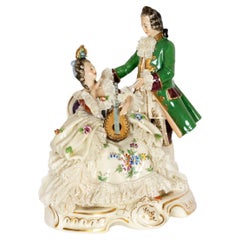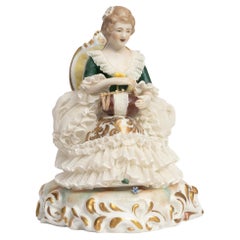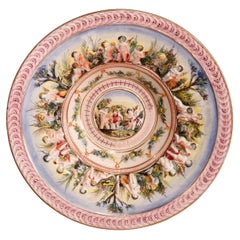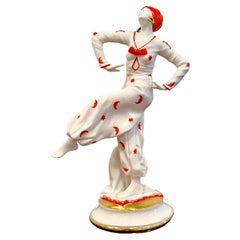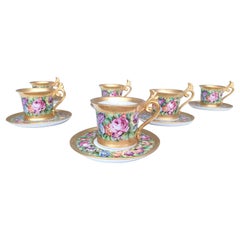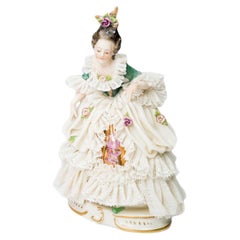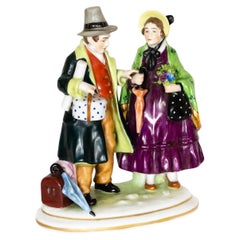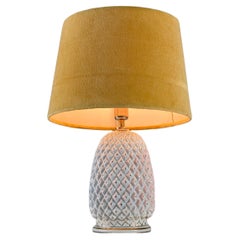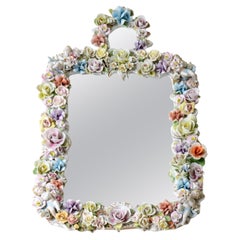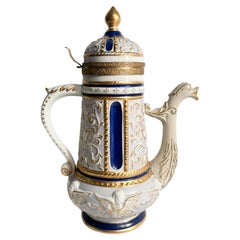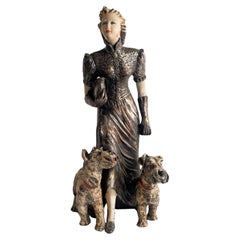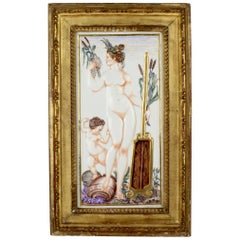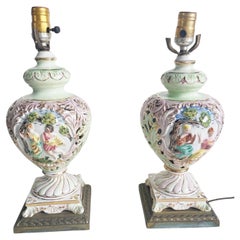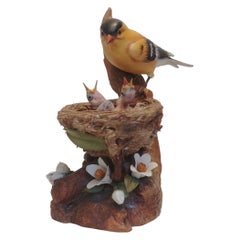Capodimonte On Sale
Early 20th Century Italian Baroque Figurative Sculptures
Porcelain
Antique 19th Century Italian Baroque Figurative Sculptures
Porcelain
20th Century Italian Neoclassical Decorative Bowls
Porcelain
Early 20th Century Italian Art Deco Figurative Sculptures
Porcelain
Vintage 1950s Italian Mid-Century Modern Tableware
Porcelain
20th Century Italian Baroque Figurative Sculptures
Porcelain
Antique 18th Century Italian Baroque Figurative Sculptures
Porcelain
Mid-20th Century Italian Mid-Century Modern Table Lamps
Porcelain
Mid-20th Century Italian Rococo Revival Wall Mirrors
Porcelain
Antique 1880s Italian Empire Tea Sets
Bronze
Vintage 1940s Italian Art Deco Figurative Sculptures
Ceramic
Antique Late 19th Century Italian Renaissance Porcelain
Porcelain
Antique Early 1900s Art Nouveau Vases
Porcelain
Mid-20th Century Italian Mid-Century Modern Figurative Sculptures
Ceramic
Mid-20th Century Italian Mid-Century Modern Figurative Sculptures
Ceramic
Vintage 1950s Italian Mounted Objects
Ceramic
20th Century Italian Neoclassical Urns
Porcelain
20th Century Italian Neoclassical Figurative Sculptures
Porcelain
20th Century Italian Neoclassical Figurative Sculptures
Porcelain
Vintage 1950s Italian Rococo Revival Figurative Sculptures
Porcelain
Vintage 1960s Italian Mid-Century Modern Figurative Sculptures
Gold
Vintage 1960s Italian Mid-Century Modern Figurative Sculptures
Ceramic
Early 20th Century Italian Renaissance Figurative Sculptures
Porcelain
Antique 1850s European Figurative Sculptures
Porcelain
Antique 19th Century Italian Animal Sculptures
Porcelain
Vintage 1960s Italian Mid-Century Modern Vases
Ceramic
20th Century Italian Baroque Decorative Bowls
Porcelain
Recent Sales
Mid-20th Century Table Lamps
Brass
Vintage 1970s Italian Romantic Animal Sculptures
Porcelain
Antique 1890s Italian Neoclassical Revival Figurative Sculptures
Porcelain
Antique 1890s Italian Neoclassical Revival Figurative Sculptures
Porcelain
21st Century and Contemporary Italian Neoclassical Revival Porcelain
Porcelain
Mid-20th Century Italian Wall Mirrors
Porcelain, Mirror
Early 20th Century Italian Renaissance Urns
Porcelain
Early 20th Century Italian Vases
Pottery, Porcelain
Antique Late 19th Century Italian Figurative Sculptures
Porcelain
Vintage 1970s Italian Mid-Century Modern Figurative Sculptures
Ceramic
Mid-20th Century Italian Romantic Figurative Sculptures
Porcelain
Antique Late 19th Century Italian Classical Roman Decorative Boxes
Porcelain
Early 20th Century Italian Rococo Table Lamps
Brass
Mid-20th Century Italian Mid-Century Modern Porcelain
Porcelain
Mid-20th Century Italian Mid-Century Modern Ceramics
Porcelain
Mid-20th Century Italian Mid-Century Modern Porcelain
Porcelain
Antique Late 19th Century Italian Porcelain
Porcelain
Antique Late 19th Century Italian Porcelain
Porcelain
People Also Browsed
2010s Italian Modern Desk Sets
Concrete
Vintage 1950s American Mid-Century Modern Screens and Room Dividers
Iron
20th Century French Art Deco Statues
Plaster
Mid-20th Century French Industrial Carts and Bar Carts
Metal
Early 20th Century Edwardian Tea Sets
Porcelain
20th Century Louis XV Trumeau Mirrors
Mirror, Hardwood, Paint
Vintage 1940s British Art Deco Vanities
Mahogany
Mid-20th Century Art Deco Animal Sculptures
Bronze
Antique Late 19th Century Brazilian Romantic Chaise Longues
Wood
Antique 18th Century French Chinoiserie Table Mirrors
Mirror, Wood
2010s Italian Vases
Ceramic
Antique 1890s Italian Baroque Revival Secretaires
Wood
Antique Early 1800s English Georgian Beds and Bed Frames
Upholstery, Mahogany
21st Century and Contemporary American American Craftsman Wall Mirrors
Wood
Antique 1730s Dutch Table Mirrors
Walnut
Antique 19th Century German Rococo Wall Mirrors
Porcelain, Mirror
Capodimonte On Sale For Sale on 1stDibs
How Much is a Capodimonte On Sale?
Capodimonte for sale on 1stDibs
If success is measured by lasting name recognition, Capodimonte porcelain would seem to be in the same league as such makers as Meissen, Sèvres and Wedgwood. Early examples of Capodimonte lamps — as well as the Italian manufacturer’s celebrated porcelain vases, figurines and sculptures — can be hard to come by, but the best later pieces possess the same over-the-top charm.
The Real Fabbrica (“royal factory”) di Capodimonte hasn’t actually produced porcelain since the early 19th century, when Charles’s son Ferdinand sold it. Although secondary manufacturers have built upon the aesthetic and kept the name alive, some connoisseurs of the royal product feel these pieces should be labeled “in the style of” Capodimonte.
The timeline of royal Capodimonte porcelain is decidedly brief. From beginning to end, its manufacture lasted approximately 75 years. King Charles VII of Naples, who founded the manufactory in 1743, began experimenting with porcelain around 1738, the year he married Maria Amalia of Saxony. No coincidence there. His new bride was the granddaughter of Augustus the Strong, Elector of Saxony and founder of Meissen, the first European hard-paste porcelain manufactory. Her dowry included 17 Meissen table services.
Struck by porcelain fever, Charles built a dedicated facility on top of a hill (capo di monte) overlooking Naples. He financed expeditions to search for the right clay. He hired chemists and artisans to experiment. His earliest successes were small white snuffboxes and vases, although efforts soon progressed to full sets of tableware, decorative objects and stylized figurines of peasants and theatrical personalities.
In 1759, Charles succeeded to the throne of Spain. He moved the manufactory with him — including 40 workers and 4 tons of clay — and continued operations in Madrid. Twelve years later, his son Ferdinand IV, who inherited the throne of Naples, built a new factory there that became known for distinctly rococo designs.
The Napoleonic wars interrupted production, and around 1807, oversight of the royal factories was transferred to a franchisee named Giovanni Poulard-Prad.
Beginning in the mid-18th century, porcelain made by Charles’s factory was stamped with a fleur-de-lis, usually in underglaze blue. Pieces from Ferdinand’s were stamped with a Neapolitan N topped by a crown. When secondary manufacturers began production, they retained this mark, in multiple variations. The value of these later 19th- and 20th-century pieces is determined by the quality, not the Capodimonte porcelain marks.
Find antique and vintage Capodimonte porcelain for sale on 1stDibs.
- What is Capodimonte's style?1 Answer1stDibs ExpertFebruary 27, 2024Capodimonte's style is regal and opulent, though it has varied over the years. Early pieces from the celebrated Italian porcelain manufacturer often reflect Rococo design sensibilities, with organic motifs rendered in soft colors. As trends changed, so did the look of Capodimonte porcelain, which skewed Victorian, Edwardian and Art Deco over the years that followed. Capodiomonte has also looked beyond its native Italy for inspiration, producing porcelain ware that reflects Japanese and ancient Roman decorative techniques. Shop a wide range of Capdodimonte porcelain on 1stDibs.
